Return to the Bay Natives Carex pansa gallery page
Check current availability of Carex pansa and Carex praegracilis at the nursery.
View a printable pdf version of this article
Carex pansa (Pacific Dune Sedge):
The sedge with the other name
By David Amme
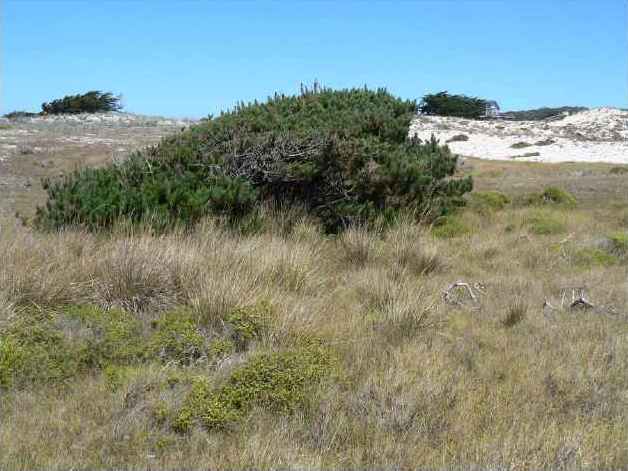
An expansive meadow of Pacific dune sedge growing with coyote brush (Baccharis pilularis) and sand reedgrass (Calamagrostis nutkaensis) surrounds a six foot wind blown Monterey Pine at Asilomar, Pacific Grove, CA.
From: Grasslands, A Publication of the California Native Grass Association, 18(4):7-10, Fall 2008
Carex pansa (Pacific dune sedge) is a native creeping, meadow-forming sedge is growing in the horticultural trade in California as a meadow or lawn substitute (Amme 2003). Pacific dune sedge is also known as sand-dune sedge and in the horticultural trade as Western or California meadow sedge that distinguishes it from “meadow sedges” known in the eastern United States. Carex pansa is a strong creeping sedge that grows intermittently along the Pacific coast in sand dune swales and meadows immediately beyond the shore. It ranges from British Columbia south to central California dunes complexes north of Point Conception including the Oceano and Guadalupe dunes south of Pismo Beach, and on Santa Rosa Island in the Channel Islands off the coast of Santa Barbara (Howitt and Howell 1964, Eastwood 1941). Carex pansa was first identified as a distinct species in 1888 by Liberty Hyde Bailey Jr., the renowned Cornell University botanist and horticulturist, who collected specimens near the mouth of the Columbia River in Oregon and Washington Territory (Bailey 1888, Curto and Fross 2006).
C. pansa is closely related to Carex praegracilis (clustered field sedge), which is inhabits seasonally moist alkaline or serpentine soils in the prairies and plains throughout most of North America from Alaska, through Canada and the Midwest, and from Washington and Oregon east of the Cascades south throughout California to Mexico and South America (Wilson et al. 2008, Hickman 1993). Carex praegracilis was named earlier than C. pansa in 1884 by botanist William Boott, from material collected near San Diego (Boott 1884). In California C. praegracilis is commonly found in wet swales in the valleys and mountain meadows west of the Sierra crest, in moist coastal strand sites, notably along the shore and serpentine soils of San Francisco Bay near Tiburon (Penalos 1963), and along the shores areas of California’s central and south coast (Howitt and Howell 1964, Hickman 1993). It is found in mesic areas in Death Valley and in the desert mountains.
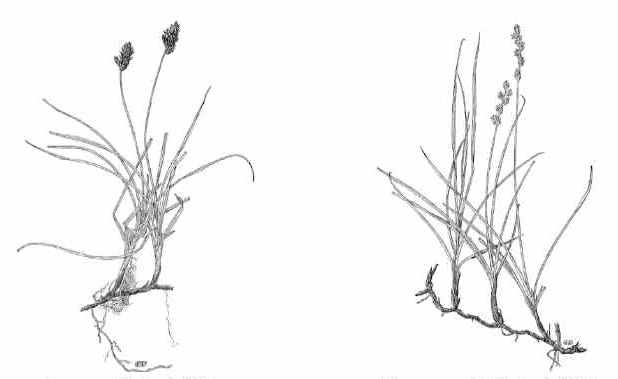
Carex pansa (Mackenzie 1940a) Carex praegracilis (Mackenzie 1940b)
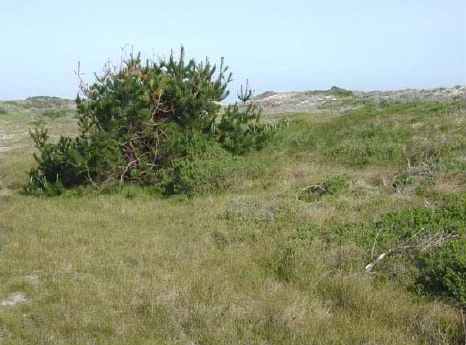
Carex pansa sweeping up the white sand dunes windward of the Asilomar State Park surrounding a Monterey pine and overtopping coyote brush.
Before the street curbs were installed around the Asilomar State Park Campus in the 1980’s, vehicles parked on the flat road shoulders clothed with the durable Carex pansa. A few cuttings were collected (by the author) on the roadsides and increased through divisions. Eventually the divisions were given to John Greenlee, California’s legendary graminoid horticulturist, to be further divided and tested. Greenlee had also selected the taller ‘Laguna’ cultivar of Carex praegracilis from the Laguna Mountains of San Diego County (Curto and Fross 2006). The first ‘Asilomar’ C. pansa meadow was created at Greenlee’s coastal test garden in Malibu, California in the late 1980’s. Eventually, enough seed was collected to grow and sell many thousands of plugs. Nurseries in the north and south coast area purchased the Asilomar selection and increased their own stocks. The numbers of C. pansa plants have been growing exponentially ever since. Carex pansa container pots and plugs are currently being produced by well over 22 nurseries and growers from San Diego to Northern California, Washington State and British Columbia (Calflora 2008).
The Asilomar ‘ecotype’ has been planted in all kinds of sites and settings from Las Vegas to San Diego to the Napa and Sonoma valleys. It is largely untested in the Eastern US but has proven durable in Texas and Colorado and grows well in all parts of California below 3500 ft. (Greenlee 1992). The Asilomar variety has been proven hands-down to be one of the finest sedges for making a lawn substitute or an unmowed natural meadow. Meanwhile, plants with similar characteristics identified as Carex praegracilis collected in the South Coast area, have also proven to be extremely effective as unmowed meadows and mowed ‘lawns’. One of the oldest and most dramatic examples of a C. praegracilis lawn exists in the Leaning Pine Arboretum on the campus of California Polytechnic State University in San Luis Obispo (Curto and Fross 2006). Around the same time an Asilomar C. pansa meadow was planted at Sonoma State College on the north side of the campus near the Environmental Technology Center.
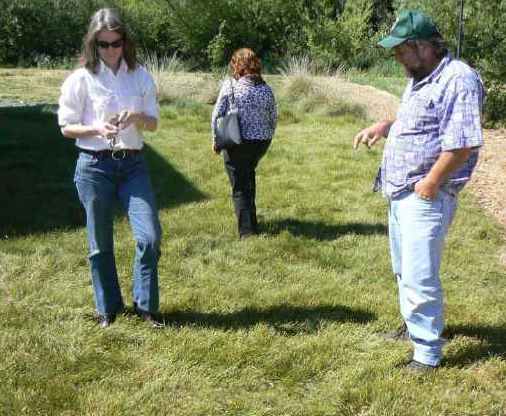
A healthy sod of Carex pansa ‘Asilomar’ at the Sonoma State College Environmental Technology Center in Rohnert Park, south of Santa Rosa, CA.
Establishing Carex pansa by broadcast seeding is very difficult because the seed is difficult to collect in large enough amounts, it is very slow to emerge in field conditions, and establishes sporadically with the increasing competition from weeds, fickle irrigation, and dry spells. Pacific dune sedge is established quickly from plugs that are grown from seed or divisions in controlled conditions and planted 6 to 12 inches on center (Greenlee 2000). If planted in the winter and spring with adequate moisture and fertilizer, the plugs will generally close canopy by the end of the first summer. Once established Carex pansa will stay green yearlong with occasional irrigation (Greenlee 1992). Plan ahead and reserve or have plugs contract grown.
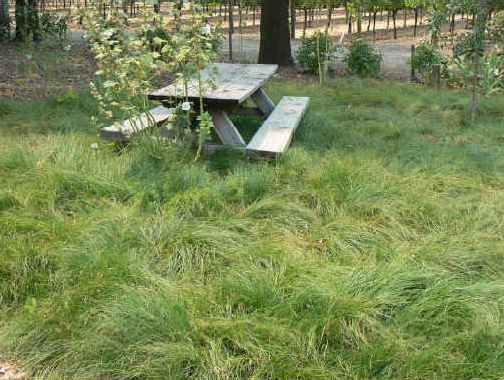
An unmowed meadow of Carex pansa ‘Asilomar’ in the Napa Valley at the Long Meadow Ranch Rutherford Gardens on Hwy 29.
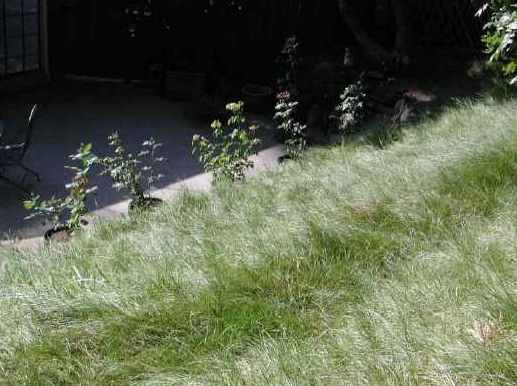
An unmowed meadow of Pacific dune sedge growing on a partially shaded hillside above a patio in a San Rafael garden.
Literature Cited
Amme, D. 2003. Creating a California meadow. Grasslands. California Native Grassland Association. 13(3):1, 9-11, 2003.
Bailey, L.H.1888. Carex pansa. Botanical Gazette. 13:82.
Boott, W. 1884. Carex praegracilis. Botanical Gazette. 9:87.
Calflora. 2008. California native plant link exchange. Carex pansa http://www.cnplx.info/nplx/species?taxon=Carex+pansa
Curto, M. and D. Fross. 2006. A sedge by another name. . .is confusing. Pacific Horticulture. July-Sept. 67(3):42-46.
Eastwood, A. 1941. The islands of southern California and a list of the recorded plants. Leaflets of Western Botany. San Francisco, California. 3(3):54-78.
Greenlee, J. 1992. The encyclopedia of ornamental grasses. Rodale Press, Emmaus, Pennsylvania. 186 pp.
Greenlee, J. 2000. Sedge lawns for every landscape. In Easy lawns: low maintenance native grasses for gardens everywhere. Ed., Steve Daniels. Brooklyn Botanic Garden 21st Century Gardening Series 112 pp.

John Greenlee with his dog Otis on a lush Carex pansa lawn in at the Molly Chapalet Winery on the east side of the Napa Valley.
Hoover, R.F. 1970. The vascular plants of San Luis Obispo County, California. U.C. Press. 35 pp.
Howitt, B.F. and J.T. Howel.1964. The vascular plants of Monterey County, California. University of San Francisco. Reprinted from The Wasmann Journal of Biology.183 pp
Mackenzie, K.K.1940a. Carex pansa. Plate 18 In North American Cariceae Ed., H.W. Rickett.
Mackenzie New York Botanic Garden. Illustrations by H.C. Creutzberg
Mackenzie, K.K.1940b. Carex praegracilis. Plate 19 In North American Cariceae Ed., H.W.
Rickett. New York Botanic Garden. Illustrations by H.C. Creutzberg.
Penalosa, J. 1963. A flora of Tiburon Peninsula, Marin County, California. The Wasmann
Journal of Biology, University of San Francisco. 21(1):1-74
Wilson, B.L., R. Brainerd, D. Lytjen, B. Newhouse, and N. Otting. 2008. Field guide to the sedges of the Pacific Northwest. Oregon State University Press. Corvallis, OR. 431 pp.
Return to the Bay Natives Carex pansa gallery page
Check current availability of Carex pansa and Carex praegracilis at the nursery.
View a printable pdf version of this article
